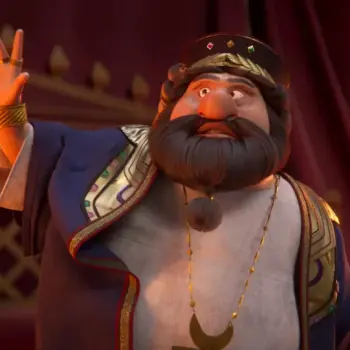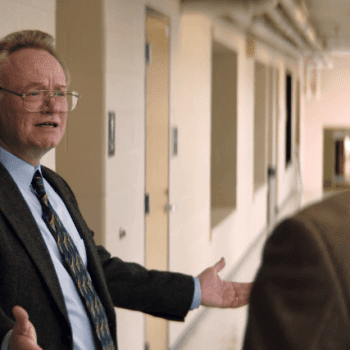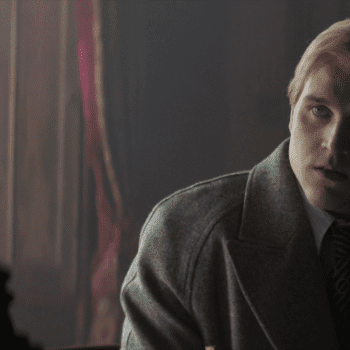
It’s not a very scary film, and it has its share of implausibilities — would a cell phone really work underground, in a subway station, when the city aboveground is being trashed? — but there is something about Cloverfield that really, really works. And that is the way the film makes use of its central gimmick, whereby we are supposed to believe that the entire movie unfolding before us is something that was found on a memory card or a video tape (it’s not clear which) in the ruins of New York City’s Central Park.
The gimmick itself is interesting, and more challenging than what The Blair Witch Project (1999) attempted nearly a decade ago. Back then, we still needed to suppose that the “found footage” was the work of documentarians, i.e. people who lug cameras around and film everything they do for a living; but now, we are asked to believe that a regular average guy would keep his home-video camera running even as he is fleeing for his life — and given that we are now living in the age of YouTube and Google Video, etc., this is not as big a stretch as it might seem. What’s more, Blair Witch was edited together from the footage left behind in two cameras, whereas Cloverfield consists entirely of footage that was found in one camera — and that imposes certain limitations on the filmmakers.
But the filmmakers do something really brilliant with this limitation: they create a back-story, indeed a series of flashbacks, by supposing that the monster attack has been accidentally recorded, in pieces, over another video that was recorded by one of the characters about a month before the monster attack takes place. So even though we are supposedly watching an unedited video, we still get a form of non-linear storytelling, and this pays off in a spectacularly poignant way at the very end of the movie. (Don’t worry, I won’t say how.)
I’ve been thinking about this aspect of the film ever since I saw it last Wednesday. I have written articles and given multi-session lectures on the subject of “memory at the movies” — and how memory is related to identity, free will, the afterlife and movies themselves — and I can sense that this aspect of Cloverfield is resonating with me strongly on that level. I’m not entirely sure how to put it in words yet, so consider this blog post a first-draft attempt.
The original recording, which we see at the very, very beginning of the film, is made by Rob Hawkins (Michael Stahl-David) after he and Beth McIntyre (Odette Yustman) have slept together for the first time, and it goes on to depict their romantic trip to Coney Island. The movie that is recorded on top of this takes place about one month later, when Rob is about to move to Japan, and his friends throw him a going-away party — a party that is briefly attended by Beth, who apparently doesn’t get along with Rob so well any more. Beth leaves the party. And then, some time later, the monster attacks New York City, and the rest of the movie follows Rob and at least three of his friends as they try to dodge the monster and the havoc it is wreaking on the city. However, instead of simply fleeing the city, Rob goes back to rescue Beth, who has called him and told him that she is stuck in her apartment. And his friends — including the wisecracking Hud Platt (T.J. Miller), who is almost never seen because he is the one actually holding the camera — join him in this rescue attempt.
Every time Hud stops recording what is going on around them, he inevitably starts up again several seconds later on the tape, or whatever memory device is being used here — and for those few brief seconds, we get a glimpse of the happy day that Rob and Beth spent together barely one month before. In a way these scenes are “flashbacks”, but in another way they are not; the past itself is popping up into the present and reminding us of the way things used to be. These happy scenes are not being spliced into the home-made disaster-movie footage; instead, they are all that remains of a happy memory that is progressively being obliterated by a much nastier one. The past was here first; it continues to assert its presence; it begs not to be forgotten.
But the film’s central gimmick runs even deeper than that. At least twice in this film, characters look at the camera and record words for posterity; and when the attack first starts, Hud says he is keeping the camera running because people who weren’t there when the monster attacked will need to know what it was like to live through that experience. So this film has been consciously filmed for the benefit of other people. But who gets to see it in the end? Almost nobody.
The opening title cards tell us that the movie we are watching was found in the ruins of New York City. That, right away, tells us that the characters failed to take the camera with them out of the city — possibly because they failed to survive, period. The opening title cards also tell us that the video we are watching is now the property of the American government. That, right away, strongly suggests that no one has been allowed to watch this video except for a handful of people who have the right clearance. If you’ll forgive the analogy, it is as though our protagonists had aimed for Heaven and now found themselves stuck in Purgatory, or even Limbo.
The old story, the happy day recorded one month ago, is undone by the new story that unfolds at the going-away party before the monster strikes. And the new story is undone by the fact that the recording has ended up in the hands of those who almost certainly will not honour the characters’ intentions. So on at least two separate levels, this movie is about thwarted memories.
Whether our experiences are happy or sad, we typically want them to have meaning — and we give them meaning by holding them in our memories and by encouraging other people to remember them, too, not only in this life but in the life beyond, as well. (Jesus tells his disciples to eat his flesh and drink his blood “in remembrance of me”; the thief on the cross tells Jesus to “remember me when you come into your kingdom.”) Cloverfield is a documentation of memories both positive and negative — and a documentation of how those memories are either obliterated or prevented from finding their proper resting place.













